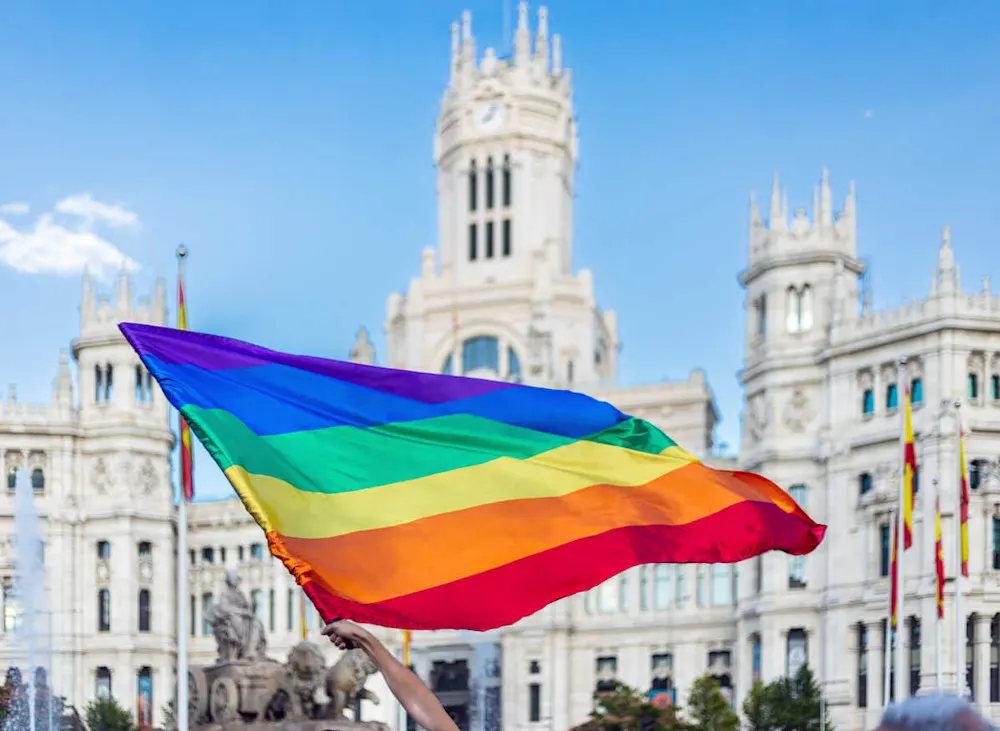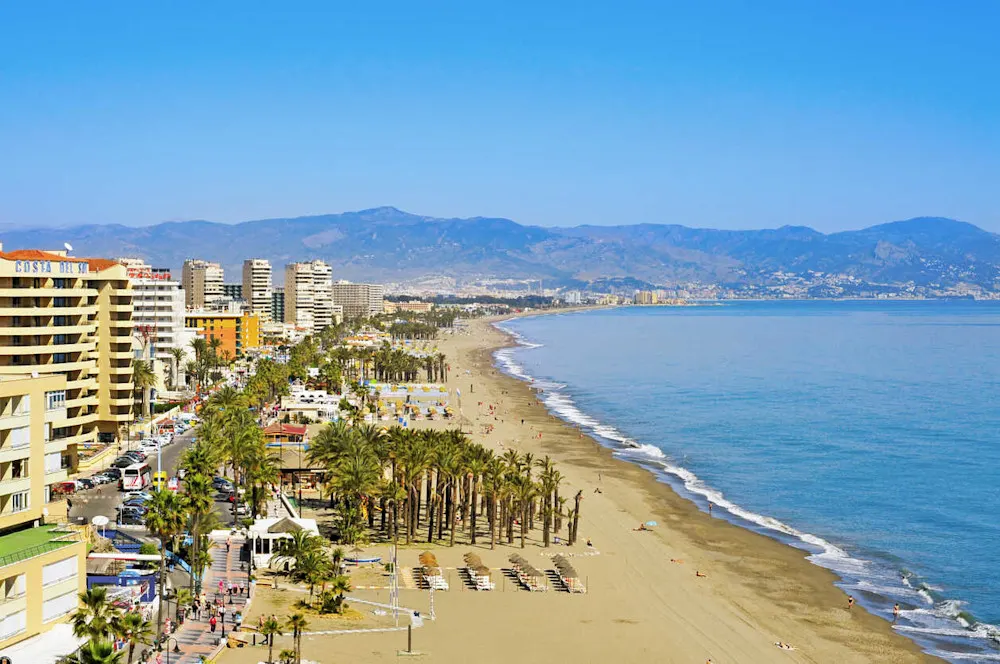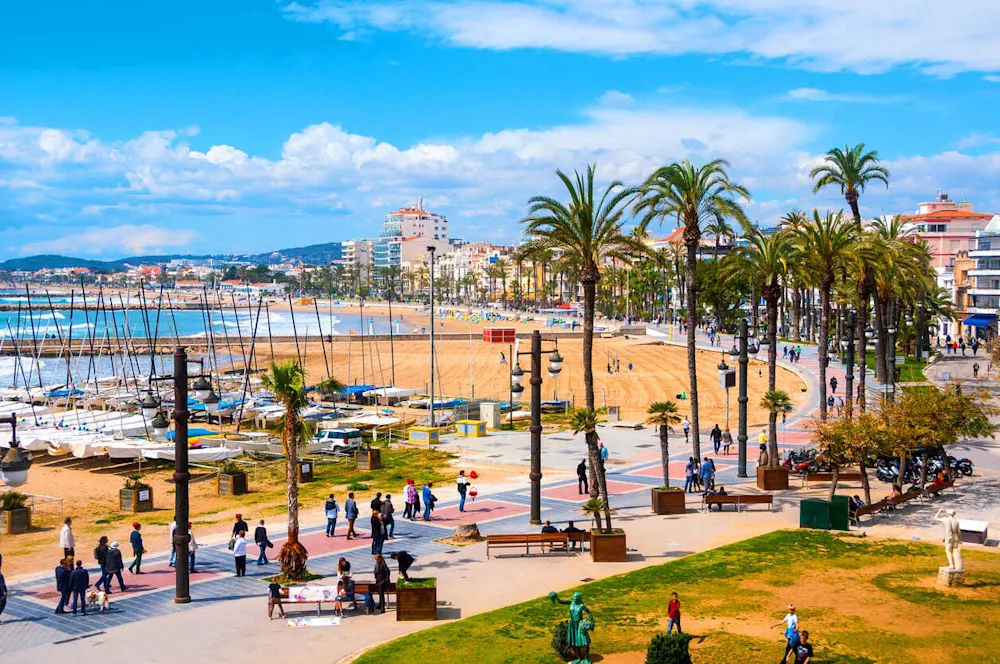To say Spain is gay-friendly is an understatement. The country doesn’t just accept LGBTQ people, it celebrates them. Rainbow flags flutter from city balconies and beach bars. “I feel like there’s more aloha here,” says Cameron English, who moved from Hawaii to Sitges on the Costa Brava. “Tolerance” and “acceptance,” he adds, “feel almost archaic. We’re completely integrated.”
While Sitges and similar enclaves attract LGBTQ residents and tourists, Spain as a whole is notably progressive, especially in Madrid, Barcelona, Málaga, and Valencia. Once a conservative Catholic nation, Spain enacted sweeping reforms in the 2000s. It legalized same-sex marriage and adoption in 2005, becoming a European leader in LGBTQ rights.
These protections reflect public sentiment. A 2021 YouGov survey found 91% of Spaniards would support a gay or bisexual family member; 87% said the same for someone trans or non-binary. Spain ranked as the most accepting of the eight countries polled.
In 2023, Spain passed a groundbreaking law allowing anyone over 16 to change their gender identity in the civil registry without medical steps, despite political backlash.
This progressive climate stands in stark contrast to the Franco dictatorship (1939–1975), when LGBTQ people faced prison, violence, even assassination. Homosexuality was decriminalized in 1979. “We came from a dark, gray dictatorship,” says Uge Sangil, head of Spain’s LGBTQ federation. “The hunger for liberty is something everyone can understand.”
As LGBTQ rights come under fire in the U.S., more gay Americans are choosing Spain. “One of the wonderful things about living here,” says Steve Aronberg, who lives on the Costa del Sol with his Danish-born husband, “is that sexual orientation simply isn’t an issue.”
Get Your Free Spain Report Today!
Get Your Free Spain Report Today!
Learn more about the lower cost of living in Spain and other countries in our free daily postcard e-letter. Simply enter your email address below and we'll also send you a FREE REPORT — Live the Good Life in Sunny, Affordable Spain.

By submitting your email address, you will receive a free subscription to IL Postcards, The Untourist Daily and special offers from International Living and our affiliates. You can unsubscribe at any time, and we encourage you to read more about our Privacy Policy.
Madrid

Spain’s capital and largest city is also the vibrant heart of its LGBTQ community, renowned as one of the most gay-friendly destinations in the world. Madrid’s queer-centric Chueca neighborhood even has its own rainbow-striped metro station. And the city’s Pride celebration is the biggest in Europe, drawing more than 2 million visitors. The main parade lasts six hours, but Pride festivities stretch across a full week.
Back in the 1970s, Chueca was a fading inner-city neighborhood just off Madrid’s glittering Gran Via. In the 1980s, after Franco’s death, Chueca attracted drug dealers, prostitutes, and counter-culture bohemians along with gays and lesbians. Even by 1998, Chueca carried a rough reputation. But gentrification soon swept in. LGBTQ investors began buying and restoring neglected buildings, property values climbed, and the neighborhood transformed. Today, Chueca brims with stylish bars, cafes, nightclubs, bookstores, and boutiques. Visitors and allies mingle with a thriving queer community.
Madrid also offers robust LGBTQ health and support services, from HIV testing and online therapy to transgender care. Groups like G-Madrid Sports connect locals through queer-oriented athletics, choir, dance, hiking, yoga, and more.
For many expats, the city offers not just freedom, but sanctuary. Episcopal priest Jeffrey Clawson moved from Los Angeles to Madrid in 2024. “In L.A., I saw hardworking undocumented people being cracked down on and armed National Guard confronting U.S. citizens. After them, will LGBTQ people be next?” he says. “Here in Madrid, I see gay couples holding hands with no fear. I feel safe—and with that, a sense of immense freedom.”

Danilo Martinez arrived in 2018, mid–coming out, to teach English through Spain’s auxiliares de conversación program. “I hadn’t even been here a week, and I already felt it—this place was special. It felt like a dream. Honestly, it still does.” He later married a Spanish man.
Ashton Dorminvil, who grew up in Brooklyn and enjoyed New York’s LGBTQ scene, was surprised to find something even more welcoming. “Madrid is gayer than New York,” he says. “After eight years living and growing here, always feeling safe, I’ve returned to the U.S. to advance my career. But I still dream of Spain. I’ve promised myself I’ll retire there.”
Torremolinos

Torremolinos, near Málaga on the Costa del Sol, is one of Spain’s most vibrant LGBTQ hotspots. Once a quiet fishing village, it began transforming into a resort town in the late 1950s. By the mid-’60s, it drew Hollywood legends like Ava Gardner, Kirk Douglas, Marlon Brando, and Orson Welles. This is where Brigitte Bardot famously went topless, and where Frank Sinatra got into trouble for speaking out against the dictatorship.
By the late ’60s, the glamor faded. Hippies took over the beaches, and in 1971, police cracked down on the town’s gay residents. Some consider this moment the unofficial beginning of Spain’s LGBTQ rights movement. After a period of decline in the 1990s, Torremolinos began a new chapter in the 2000s, fueled by LGBTQ tourism. A major downtown renovation in 2018 sealed its comeback.
Today, this thriving city of 68,000 draws visitors from around the world. Tourist spending and hotel occupancy are at all-time highs, driven by a lively queer nightlife and events all year long. Pride brings in 50,000 revelers. Rainbow flags fly proudly above beachfront bars and restaurants. The once-neglected La Nogalera strip mall, near the train station, now pulses with gay bars, discos, and cafés.
“Being gay here is the same as being ordinary,” says Richard Jasicki, who moved with his husband from sunny San Diego to Torremolinos in 2022. They enjoy palm-lined beaches, seaside wine and seafood at local chiringuitos, and Mediterranean views from their ninth-floor condo. “The vibe is relaxed,” he says, “but the big difference is people don’t go out until after 11 p.m. Only by midnight does everywhere really get going. You can party all night if you want. And it’s extremely safe.”

Adam Fitzgerald, a former New Yorker, moved to Torremolinos during the 2020 pandemic. He now works as a theater consultant and relationship coach from a modest top-floor apartment. “It’s nothing fancy,” he says, “but it’s 15 minutes to the beach, 15 to the town center. Buying in New York wasn’t even possible. Here, it is. The system makes it doable, not just for the ultra-rich.”
Adam describes the local LGBTQ vibe as “live and let live.” Whether you’re hitting the clubs five nights a week or enjoying quiet picnics in the park, “whatever you want is fine. People lead with kindness here. It’s a friendly, easygoing place; no one cares what you’re wearing or what car you drive. It’s just very welcoming and really lovely.”
Sitges

Sitges, a former fishing village just 22 miles southwest of Barcelona, is often called “the gay capital of Europe.” It’s one of the top LGBTQ holiday spots on the continent, known for its vibrant nightlife and welcoming vibe. With 17 beaches, including nude and gay beaches, plus 20 gay bars, spas, boutiques, and more than 4,500 hotel beds, Sitges draws a global crowd. About 35% of its 32,000 residents hail from France, the U.K., the Netherlands, and Scandinavia, lending the town a distinctly international feel.
The town’s LGBTQ history stretches back to 1891, when Spanish painter, poet, and playwright Santiago Rusiñol settled here. “His Bohemian, homo and bi friends followed,” explains British expat Brandon Jones, a resident of Sitges for 40 years. “Then the Barcelona bourgeoisie began sending their gay sons to Sitges, and they brought their friends.” During the Franco years, Sitges became a quiet refuge for LGBTQ people. “It was always easier to be gay in Sitges than elsewhere in Catalonia,” says Brandon, “even if you had to stay discreet.”

Bailey Franklin and his husband, Robert Alvarado, moved from Los Angeles to Sitges in February 2025. Both remote workers, they qualified for Spain’s Digital Nomad Visa. Bailey, 57, is an LGBTQ-affirmative psychotherapist seeing U.S. clients online. Robert, 45, is an accountant who works entirely digitally. “We were able to just get up and go,” says Bailey.
They now rent an 800-square-foot, three-bedroom home in the Poble Sec neighborhood for €1,500 ($1,733). Health insurance, required for the visa, came as a pleasant surprise: Bailey had been paying $450 a month for basic coverage in L.A. Now, they pay €187 ($216) a month total, with no deductibles or co-pays. Their monthly budget, excluding food, is about €2,151 ($2,485).
“I'm originally from Manhattan, I have a soft spot for what I would consider cosmopolitan living, where I feel like I'm surrounded by people from all over the world,” says Bailey. “This is the first place that I've been that has managed to be both a village and cosmopolitan. It’s like a Palm Springs, Fire Island, Provincetown, Greenwich Village, where everybody's welcome. I've stopped trying to guess what people are or aren't, especially when it comes to trans issues. My brain is out of the habit of categorizing people.”
Peter and Cameron English originally planned to retire in Portugal. A twist of fate led them to Greece, where they fell for Kalamata—“like Hawaii, but much more affordable.” But the charm wore thin in winter. “It was cold, isolating, and rural,” says Peter. “We weren’t ready for that.”
In early 2024, they took a trip through Spain, visiting Málaga, the Costa del Sol, Granada, Ronda, Barcelona, and Sitges. “We realized everything we’d been missing was right here,” says Cam. “Modern infrastructure, public transport, a cosmopolitan atmosphere. And the difference in LGBTQ acceptance? Night and day.”
In Greece, Cam says, homosexuality is tolerated in Athens and Mykonos, but elsewhere, “it’s like the 1950s.” In Spain, they saw same-sex couples holding hands. “We felt normal,” he says. After 18 months in Greece, they moved to the center of Sitges in December 2024.
“Here, you go to an event and there are gay people, families, young, old, gay, straight—everyone,” Cam says. “That’s what we love.” Peter adds, “Nobody cares who you are. Be yourself. I’ve lived in New York, L.A., San Diego, but I’ve never felt this free.”
Daniel Vickers, a screenwriter and author, splits his time between Sitges and Barcelona with his husband. They moved from Washington, D.C., in 2017, drawn to Barcelona’s energy, affordability, and laid-back feel. In 2020, they bought a second home in Sitges. “We love city life,” Daniel says, “but Sitges has a great community, amazing food, nightlife, beaches, and a chill lifestyle. When we want, we head to Barcelona. It’s the best of both worlds.”
He adds, “Spain proves that strong religious faith can coexist with LGBTQ acceptance. For a country with deep Catholic roots, both the government and the people are incredibly supportive. No one blinks when I say ‘my husband.’ That says everything.”
Barcelona

Magical Barcelona is Spain’s second-largest city, a global tourist destination, and one of the most LGBTQ-friendly cities in Europe. Alongside Antoni Gaudí’s iconic modernismo architecture, the city features gay, clothing-optional beaches like Mar Bella and Sant Sebastià, an LGBTQI+ Center in the Sant Antoni neighborhood, the vibrant Gaixample district, and an openly gay mayor, Jaume Collboni.
Gaixample is the heart of Barcelona’s LGBTQ community, filled with gay-friendly restaurants, bars, shops, cafés, and nightclubs. A replica of Keith Haring’s AIDS mural stands beside the MACBA contemporary art museum. Each May and October, Gaixample hosts Queer Market, a lively exhibition featuring vendors, live music, food trucks, information booths, and entertainment.
In 1977, just two years after the end of Franco’s dictatorship, 4,000 LGBTQ people and allies marched down Barcelona’s busy La Rambla to demand gay rights. Though the protest was broken up by police and future demonstrations were banned, the spirit of Pride had taken root in the city. Many consider this the beginning of Spain’s LGBTQ rights movement.
Christopher Macken, a social media influencer, real estate entrepreneur, and beauty expert, arrived in Barcelona on April 22, 2025, with two dogs and his Hungarian-born partner. Originally from a small town in Georgia, the 43-year-old had spent 17 years in Atlanta. Soon after arriving, the couple decided to get married.
They had already purchased a penthouse in a historic building in the Gothic Quarter. Christopher describes their three-bedroom, two-bath home with a private rooftop terrace as “monumentally cheaper than my home in Atlanta Midtown…which is smaller.” The structure was originally built for a prominent Catalan family. “It’s a humbling feeling to stand in streets and buildings that were constructed before your entire form of government was even established.”
One morning while jogging in Parc de la Ciutadella, Christopher noticed a gazebo. A nearby sign explained that the park is dedicated to Sonia Rescalvo Zafra, a trans woman murdered by neo-Nazis in October 1991. Her death spurred both the Spanish and Catalan governments to denounce hate crimes and enshrine LGBTQ protections in their constitutions.
“I left a country that’s still arguing about what bathrooms people should use,” Christopher says. “And here, we have a country that’s changing its constitution and denouncing hateful, archaic rhetoric. I’m proud of my new country. I hope my homeland can learn from its elders.” During their first 90 days, he and his husband referred 25 Americans to local expat relocation services. “This is a place where my husband and I don’t have any reservations about being ourselves. People here have an overwhelming respect for individuality.”

Nicholas Spengler, 38, originally from Vermont, was teaching at a university in England when he fell in love with another academic from Barcelona. They moved to the city together in 2021. “It’s great to have my partner’s family close by, and my mother recently relocated here from the U.S. as well.”
Now teaching English literature at a local university, Nicholas lives with his partner in the old town. “Barcelona is famous for LGBTQ clubs and festivals, but I appreciate the more low-key elements of the queer community—from local bars and restaurants to the beaches, where you see a real mix of ages and bodies, especially at nudist areas like Sant Sebastià and Mar Bella. It’s a friendly and comfortable place to be queer.”
Nanine Alexander and Tamsen Wassell moved to Barcelona from Portland, Oregon, in January 2014 for its climate, culture, cost of living, and access to the rest of Europe. The couple recently remodeled their apartment in the Vila Olímpica, an area developed for the 1992 Olympics, to ensure they can age in place comfortably. Tamsen says, “We’re not very LGBTQ-focused. We know a lot of interesting people, and we don’t care who they sleep with. They don’t care that we’re in a long-term relationship. For us, in Barcelona, sexual orientation has become a non-issue in our lives.”
Get Your Free Spain Report Today!
Get Your Free Spain Report Today!
Learn more about the lower cost of living in Spain and other countries in our free daily postcard e-letter. Simply enter your email address below and we'll also send you a FREE REPORT — Live the Good Life in Sunny, Affordable Spain.

By submitting your email address, you will receive a free subscription to IL Postcards, The Untourist Daily and special offers from International Living and our affiliates. You can unsubscribe at any time, and we encourage you to read more about our Privacy Policy.
